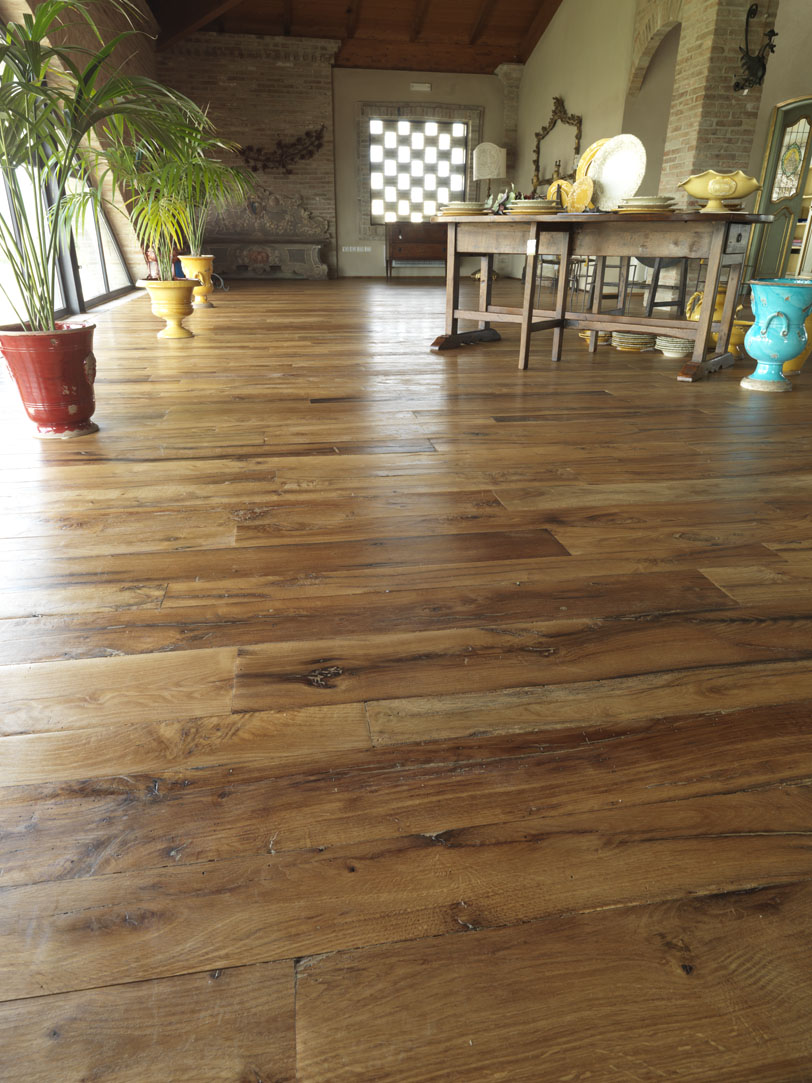Our antique oak wood floor is the result of the processing of beams and old boards.
The slow maturing, lasting for centuries, has enhanced the qualities of this prestigious material.
The antique oak parquet, with its amiable tone the yellowish sapwood and the dark brown is considered to be one of the best woods for the construction of floors.
The beauty of the grain shows off in large surfaces, where you can admire the narrow sapwood, of gray-yellow light, blend in with the darker tones of the heartwood.
The long experience of this heavy and tenacious timber has dressed in a unique charm and sometimes, thanks to the air, has darkened its appearance. The cracks, the knots and the chromatic variegations of the antique oak floor of recovery have been enhanced by the patina of an immemorial time, like a veil of beauty laid over the strength of this wood, stable under all pressure, motionless under the tread of entire lives.
Technical Description Antique Recovery Oak Wood Flooring
Lacole Casa Italiana recovers ancient beams coming from the demolition of old houses and buildings.
The beams are then regenerated in a unique plank parquet, enhancing and identifying the place where they will be placed.
The re-use of old beams takes place minutely: each piece recovered is cut and worked by hand.
The planing process is used to eliminate the scratching obtained by the saw when cutting the beams into boards and makes the wood more smooth to the touch and similar to the original parquet that have achieved this effect thanks to the trampling of time.
Brushing, on the other hand, is a treatment that allows to obtain a more rough effect by highlighting the grain of the wood.
Generally it is more recommended for environments that require a rustic parquet.
A meticulous work that requires patience, precision but above all passion and which lets all the nuances of wood emerge.
The holes in the woodworms, the signs of the weather, the trampling then make our parquet in antique oak wood unique.
Composition, orientation, geometry and type of installation
Composition: Unique plank of noble wood (solid wood), thickness 2 CM or different on request.
Lengths: The boards are divided into 4/5 groups from minimum 50CM up to 400CM according to the ancient beams available.
Widths: The tables are divided into 4/5 groups from a minimum of 9 CM up to 25/30 CM based on the ancient beams available.
Surface processing: The planks can be brushed to obtain a more rustic effect, planed by hand for a smoother and more elegant effect, or sawn.
Lateral work: The planks can be simply trimmed or grooved sideways so as to insert a strip that allows them to be interlocked with each other for mounting or even with a tongue-and-groove joint system.
Laying orientation: it depends on the main lighting source of the room, which may be the terrace window for example.
The elements must be laid longitudinally with respect to the incident light.
By making good use of the choice of laying orientation, the proportions of the room can be accentuated.
The laying geometry is a regular formwork as used in the past.
In regular formwork, the individual elements of the same width and length are arranged in the direction of their length, so that the butt joints occur in the same center line or in a constant position with respect to the planks of the previous row.
Laying types:
INSTALLING BY BONDING
FLOATING OR FLOATING LAYER: the planks are simply placed on the laying surface and joined with interlocking elements.
Treatment and maintenance
Treatment: Generally the antique recovery oak floor is supplied ready for laying but without treatment that is carried out after assembly.
In the event that it is requested, we can provide treatment.
Maintenance: Cleaning can be done just like new wood floors. Remove the dust periodically using a broom and a cloth to eat dust (or vacuum cleaner).
Clean regularly with a cloth dampened in water and a specific detergent for wooden floors in order to improve hygiene.






